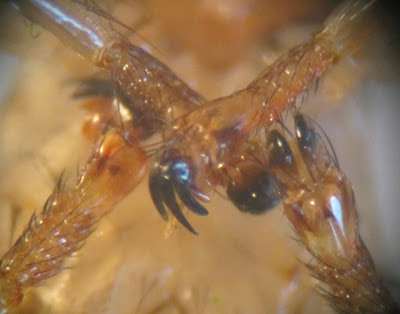Early mornings, lack of sleep, mozzies, trainees and flat flies are among several of the hardships that ringers must endure. Flat flies just pip trainees to the post for the most irritating and disgusting; after all, the latter can carry things and sometimes they bring cake. A mere glimpse of one (talking flat-flies now) can send the most hardened ringer in to girly flaps of "Ew! Ew! Ew!".
Most of the species of flat-fly encountered by ringers belong to the family Hippoboscidae, which contains about 200 species world wide but only 13 have been recorded in the UK. Flat-flies are blood feeders and can be restricted to a single host species (monoxenous), a number of closely related host species (stenoxenous) or pretty much anything with fur or feathers (polyxenous). They are all bloody impossible to squish.
Our recent catches of house martin have been accompanied by one representative of the Hippoboscidae; Crataerinia hirundinis. This critter, as its name suggests, is pretty found of hirundines. In the UK it’s nearly exclusively found on House Martins but will sometimes piggy back on the other two species, as well as Swifts and even House Sparrow when they take over House Martin nests.
C. hirundinus is a stay at home kind of ectoparasite being closely associated with the House Martin’s nest and doesn’t appear to have been recorded in Africa. Infestations can be as high as 40 or more but the most we’ve counted one individual was 6, one of which is displayed in all its “glory” for your delectation:
 |
| C. hirundinis; looks like something from Ridely Scott's imagination... |
 |
| Those wings are completely useless. |
 |
| Freaky feet; designed for grasping on feathers and stuff. |
 |
| Bottoms up! |
These and other interesting facts about flat-flies were obtained from:
Hutson (1984). Keds, Flat-flies and Bat-flies, Handbook for the Identification of British Insects, vol 10, part 4. Royal Entomological Society of London.





.jpg)